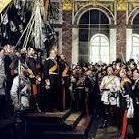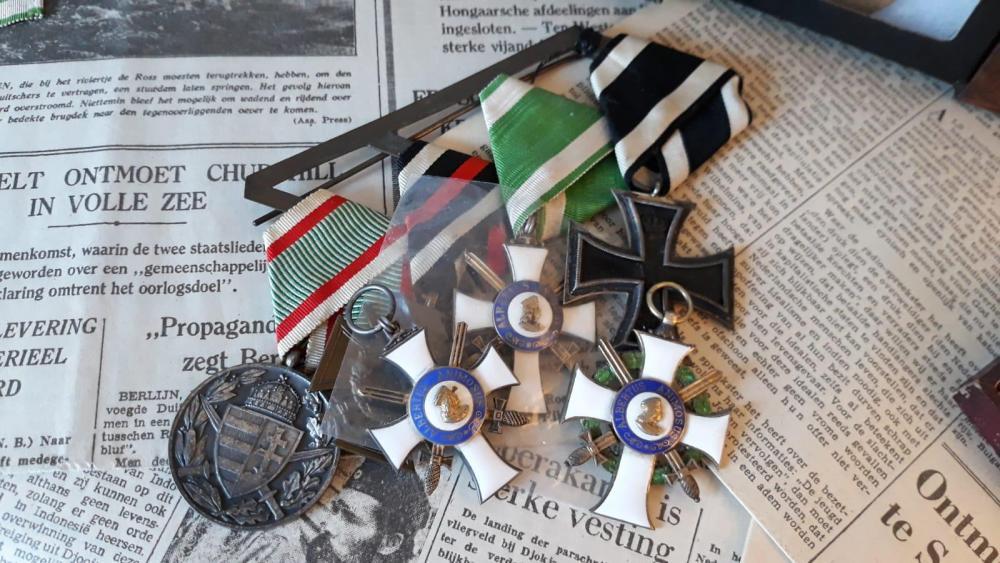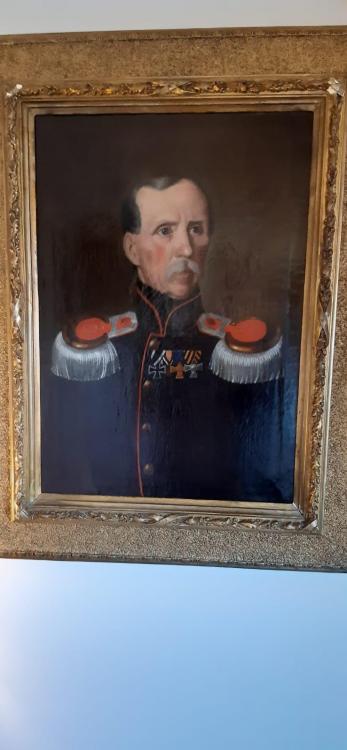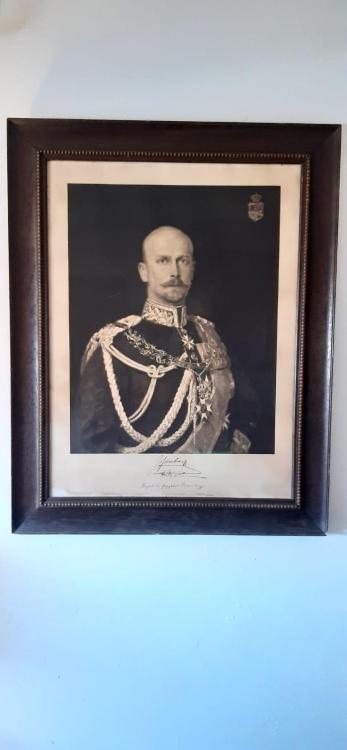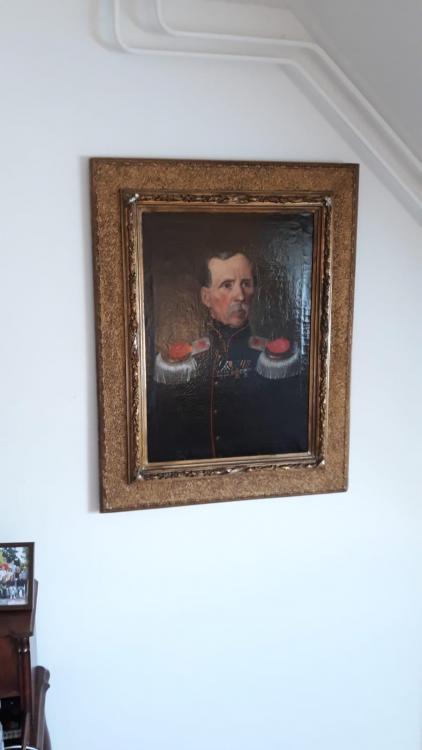-
Posts
674 -
Joined
-
Last visited
-
Days Won
6
Content Type
Profiles
Forums
Blogs
Gallery
Events
Store
Everything posted by laurentius
-
Because he earned them. Within imperial collection there are basically three schools of thought. 1. All decorations belonging to the same order may be worn together (which goes for most orders/decorations) 2. All decorations belonging to the same order are allowed to be worn, if they were earned in different conflicts 3. Only one class is allowed to be worn Now, rules were broken, after 1918 there were no people anymore to tell you you were in the wrong with the way you wore your decorations, which lead to some freaky medalbars between 1918 and 1933. In 1934 the nazi's cleaned house, banning certain orders for the newly established FEK A great example of rule number 2 is Franz Ritter von Epp who earned three different grades of the BMVO. This was the reason he was allowed to wear all three, which he often did. Although the BMVO isn't the rarest of orders (around 41.000 awarded I believe, ofcourse a number where handed out two or three times, so the actual number is much lower) I think Epp is one of only a dozen officers with three grades. Now, back to Waldeck-Pyrmont. As far as I know (more knowledgeable collectors please correct if wrong) there were no rules stating that only one grade was allowed to be worn. I also believe we have more pictures of recipients who wore both the 4th and 3rd class at the same time. Hope this helps. Kind regards, Laurentius
-
I agree with your conclusion, now we have to find out the remaining seven. Would anyone be able to help us with information from the ranklists, that might give us the final clue which will help us solve this puzzle? Kind regards, Laurentius It is my experience that the past often allows us, all of us, to romanticize a bit. Not to worry, we all do it, especially when around our collection
-
Since the Crownprince actually held a command he didn't travel as much as his father, so the people who would usually travel with him (aide-de-camps, servants, etc.) also received less decorations. A person who served as an aide on the western front had less contact with foreign powers, and therefore a smaller chance of getting a foreign award. 'Being noticed' is key here Whether someone received foreign decorations (in our case often ÖMVK or Iron Crescents) didn't depend on rank, but rather on connection. Two officers fighting side by side might have a very different type of awards in their possession, depending on the regiment they served in. I recall, one of the first forums posts I made back in 2017 was regarding the subject of how unlucky the average Prussian soldier was. Whereas soldiers from the German states often had a chance for an EK2 and the decoration from their state, the Prussian only had the EK2. However, if a soldier was lucky he had a regiment with a foreign inhaber, giving him a chance at another decoration. Let's say we have a medalbar with an EK2 and a MMVK2. He might have been a Prussian with a Mecklenburgian regimental commander, or simply a Mecklenburgian. This is one of the reasons even the simplest of bars can be most interesting Kind regards, Laurentius
-
Dear David, The Prussians did count strict, and most awards of the PDA were after the war, most were given out in 1919 and 1920 as belated awards. It seems therefore unlikely that this is a PDA, perhaps he took part in other activities that would have 'sped up' the count of his PDA? Spending time aboard ships in the German navy before WW1 also counted double, did he perhaps go to the colonies? It could also be the Crownorder, or some other decoration with a blue ribbon. The ribbon looks more reddish to me, I'm also missing the two vertical yellow stripes which we usually see with the BrK. Kind regards, Laurentius
-
Dear David M First Picture: 1. EK2 3. PDA 7. PRAO 10. Zentenarenmedaille I hope this helps a bit, I'm not sure about number seven, since that seems to be the wrong position for a PRAO. A zoom-in of the picture might help with the identification of the rest of the ribbons. I can't help you with the second picture, although I have a strong suspicion that the last medal on the medalbar is also the zentenarenmedaille. This depends, when looking at Prussian medal- and ribbonbars we basically see two styles of bars. The style you refer to where Prussian decorations are worn first, regardless of the importance of the medal (where a simple commemoration medal might come before a highly regarded foreign Order). The other style we see is the one where wartime decorations are worn before the peacetime decorations, usually in the order. War time German homestate awards-wartime other German states awards-Wartime foreign states awards. This cycle would be repeated at the end of the medalbar, but with peacetime awards. Looking at the first picture I have a feeling you might be right, that his Prussian decorations are worn first, however, without proper identification this can not be said for certain. Hope this helps. Kind regards, Laurentius
-
You are correct, the Order of St. Anna has red arms, or sometimes black on custom-made pieces. Given his rank as Konteradmiral and the fact that he is wearing an Oldenburg cross on his medalbar leads me to believe the second decoration around the neck might be the Oldenburg Haus- und Verdienstordens with swords. This would explain the pieces between the arms and it has the same shape as the decoration seen in the pictures. I hope one of the more senior collectors in possession of the ranklists might be able to confirm my opinion. Kind regards, Laurentius
-
Dear Don, I think the last three decorations are the Swedish Order of the Sword/Austrian Order of the Iron Crown, the Russian Order of St. Stanislaus and the one at the end is the Austrian medal for soldiers in the foreign regiments of the Austrian emporer, I have forgotten the name, I do know it is rare. This medal would also go well with the ÖMVK and the Order of the Iron Crown. Given the combination I suspect the third medal from the right to be the Austrian Order of the Crown, but it could also be the Swedish Order of the Sword, since those were relatively often awarded to German officers. Lovely painting, I hope I've been able to help you a bit. Kind regards, laurentius
-
I agree here with Sampo, most likely a buttonhole-miniature for some Belgian official, purchased in The Hague at the Van Wielik store. This colour is not at all correct for the Legion D'Honneur. Although the ribbons for Belgian orders are Purple, they often have a burgundy-red appearance, which is also visible here.
-
I could only discern the first four decorations of his ribbonbar, which you have already listed, them being EKII, HoHx, RAO4, KO3 or PDA. I am leaning toward the PDA, because the blue is a bit too dark for the KO and he might already have taken it off his ribbonbar because of the KO2x. Hope this helps. Kind regards, Laurentius
-
Here is another picture of the painting which I have taken this morning It's rather hard to distinguish due to the flash, but there is a small 5 painted on each of the shoulderboards. Here are two other pieces from my collection, not related to the topic here, but I thought I'd be nice to show them. I don't know the name of the Oberleutnant in the first painting. The second piece is a drawing of Johann Albrecht of Mecklenburg, who served as regent of Braunschweig between 1908 and 1913. The piece is from that time, all original except for the new glass. Kind regards, Laurentius
-
Would it be possible to find out why he got the RG5? Is there a list of Prussian recipients? I know there is a list of recipients who received it during the Franco-Prussian war. Kind regards and thanks in advance, Laurentius
-
Dear Arb, How peculiar, I bought it from the family (who also supplied the diary excerpt and the documents) and they said it was painted around 1830, they could have been mistaken ofcourse. I always thought it weird because without the fringes it would be just a Sec.Lt. for which he seems too old in the picture. If the painting was made after 1841 that would mean he would atleast be 53 which is much more believable in my opinion. In the painting he is wearing 4 decorations (EKII, Medal for 1813 I presume (?), PDA, RG5). Since he was still alive in 1863 I would assume he also received the Erinnerungs-Kriegsdenkmünze für 1813-1815? Ofcourse this being a commemorative medal it doesn't show up in the ranklists. I'd like to thank all of you who have contributed to this thread. Kind regards, Laurentius
-
I think you might be right here. The document I have for the veterans still alive in 1863 describes this problem and how it was handled. It also describes a rather lovely lunch the veterans received at the royal palace. The timeframe for the award is post 1817 but before 1830 when the painting was made. This would fit neatly into your frame from 1817 to 1824. Kind regards, Laurentius
-
Dear Arho, the excerpt, only three pages, covers a few days in 1812, where he recounts his promotion, and a few of his men. It is more than a collection of notes. He did get his EK early on, in the first year of awarding (autumn 1813), was there already then a shortage, or was he given the EKII for bravery from a retrospective point of view? Kind regards, and thanks in advance, Laurentius
-
Dear Arb, thank you, that's the man I was looking for, I bought a painting last year of him and I wanted to see if there was any more information on him. With the painting also came an excerpt of his diary and some information on himself. I also received a document containing all the recipients of the EK 1813 still alive in 1863 at the 50th anniversary of the decoration. Here is the painting, as you can see he is still a Sec.Lt. here, in his diary he describes being given this rank in 1812. Kind regards, Laurentius
-
Dear fellow collectors, I am looking for information on Major a.D. Leber who earned an EK2 1813 at the battle of Groß Görschen, I'm looking for confirmation whether he also received the Russian cross of St.George. His name was Johann Christian Leber, he was born in 1788, and died in 1873 Thanks in advance and kind regards, Laurentius
-
Kriegsdekoration is not a term used when talking about the Albrechtsorden. First class decorations (regardless whether they are with or without swords) come with a wreath, which in some countries (like Austria) might be seen as a kriegsdekoration. The swords are in this case the kriegsdekoration, which means he had an Albrechtsorden 1. class (SA3aX)


